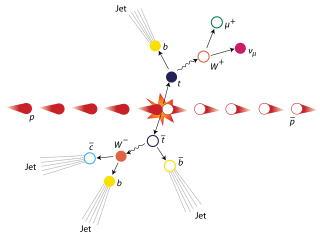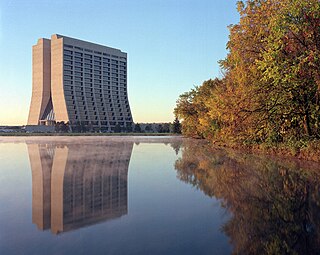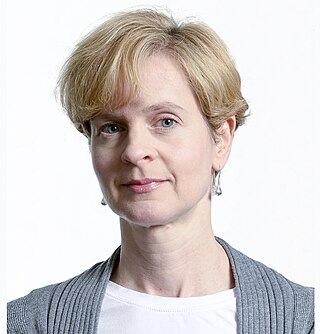
Omega baryons are a family of subatomic hadrons which are represented by the symbol
Ω
and are either charge neutral or have a +2, +1 or −1 elementary charge. Additionally, they contain no up or down quarks. Omega baryons containing top quarks are also not expected to be observed. This is because the Standard Model predicts the mean lifetime of top quarks to be roughly 5×10−25 s, which is about a twentieth of the timescale necessary for the strong interactions required for Hadronization, the process by which hadrons form from quarks and gluons.

The charm quark, charmed quark, or c quark is an elementary particle found in composite subatomic particles called hadrons such as the J/psi meson and the charmed baryons created in particle accelerator collisions. Several bosons, including the W and Z bosons and the Higgs boson, can decay into charm quarks. All charm quarks carry charm, a quantum number. This second-generation particle is the third-most-massive quark, with a mass of 1.27±0.02 GeV/c2 as measured in 2022, and a charge of +2/3 e.

The top quark, sometimes also referred to as the truth quark, is the most massive of all observed elementary particles. It derives its mass from its coupling to the Higgs boson. This coupling yt is very close to unity; in the Standard Model of particle physics, it is the largest (strongest) coupling at the scale of the weak interactions and above. The top quark was discovered in 1995 by the CDF and DØ experiments at Fermilab.
The bottom quark, beauty quark, or b quark, is an elementary particle of the third generation. It is a heavy quark with a charge of −1/3 e.

In particle physics, the W and Z bosons are vector bosons that are together known as the weak bosons or more generally as the intermediate vector bosons. These elementary particles mediate the weak interaction; the respective symbols are
W+
,
W−
, and
Z0
. The
W±
bosons have either a positive or negative electric charge of 1 elementary charge and are each other's antiparticles. The
Z0
boson is electrically neutral and is its own antiparticle. The three particles each have a spin of 1. The
W±
bosons have a magnetic moment, but the
Z0
has none. All three of these particles are very short-lived, with a half-life of about 3×10−25 s. Their experimental discovery was pivotal in establishing what is now called the Standard Model of particle physics.

In particle physics, a tetraquark is an exotic meson composed of four valence quarks. A tetraquark state has long been suspected to be allowed by quantum chromodynamics, the modern theory of strong interactions. A tetraquark state is an example of an exotic hadron which lies outside the conventional quark model classification. A number of different types of tetraquark have been observed.

The Underground Area 2 (UA2) experiment was a high-energy physics experiment at the Proton-Antiproton Collider — a modification of the Super Proton Synchrotron (SPS) — at CERN. The experiment ran from 1981 until 1990, and its main objective was to discover the W and Z bosons. UA2, together with the UA1 experiment, succeeded in discovering these particles in 1983, leading to the 1984 Nobel Prize in Physics being awarded to Carlo Rubbia and Simon van der Meer. The UA2 experiment also observed the first evidence for jet production in hadron collisions in 1981, and was involved in the searches of the top quark and of supersymmetric particles. Pierre Darriulat was the spokesperson of UA2 from 1981 to 1986, followed by Luigi Di Lella from 1986 to 1990.

In particle physics, quarkonium is a flavorless meson whose constituents are a heavy quark and its own antiquark, making it both a neutral particle and its own antiparticle. The name "quarkonium" is analogous to positronium, the bound state of electron and anti-electron. The particles are short-lived due to matter-antimatter annihilation.

The Collider Detector at Fermilab (CDF) experimental collaboration studies high energy particle collisions from the Tevatron, the world's former highest-energy particle accelerator. The goal is to discover the identity and properties of the particles that make up the universe and to understand the forces and interactions between those particles.

The DØ experiment was a worldwide collaboration of scientists conducting research on the fundamental nature of matter. DØ was one of two major experiments located at the Tevatron Collider at Fermilab in Batavia, Illinois. The Tevatron was the world's highest-energy accelerator from 1983 until 2009, when its energy was surpassed by the Large Hadron Collider. The DØ experiment stopped taking data in 2011, when the Tevatron shut down, but data analysis is still ongoing. The DØ detector is preserved in Fermilab's DØ Assembly Building as part of a historical exhibit for public tours.

Neutral B meson oscillations are one of the manifestations of the neutral particle oscillation, a fundamental prediction of the Standard Model of particle physics. It is the phenomenon of B mesons changing between their matter and antimatter forms before their decay. The
B
s meson can exist as either a bound state of a strange antiquark and a bottom quark, or a strange quark and bottom antiquark. The oscillations in the neutral B sector are analogous to the phenomena that produce long and short-lived neutral kaons.

The
B
s meson is a meson composed of a bottom antiquark and a strange quark. Its antiparticle is the
B
s meson, composed of a bottom quark and a strange antiquark.

ARGUS was a particle physics experiment that ran at the electron–positron collider ring DORIS II at the German national laboratory DESY. Its aim was to explore properties of charm and bottom quarks. Its construction started in 1979, the detector was commissioned in 1982 and operated until 1992.
In particle physics, B mesons are mesons composed of a bottom antiquark and either an up, down, strange or charm quark. The combination of a bottom antiquark and a top quark is not thought to be possible because of the top quark's short lifetime. The combination of a bottom antiquark and a bottom quark is not a B meson, but rather bottomonium, which is something else entirely.

In particle physics, the phi meson or
ϕ
meson is a vector meson formed of a strange quark and a strange antiquark. It was the
ϕ
meson's unusual propensity to decay into
K0
and
K0
that led to the discovery of the OZI rule. It has a mass of 1019.461±0.020 MeV/c2 and a mean lifetime of 1.55±0.01 × 10−22s.

Wendy Taylor is an Experimental Particle Physicist at York University and a former Canada Research Chair. She is the lead for York University's ATLAS experiment group at CERN.

Daniela Bortoletto is an Italian-British high energy physicist, head of Particle Physics at the University of Oxford and Nicholas Kurti Senior Research Fellow in Physics at Brasenose College, University of Oxford. She works in silicon detector development and was a co-discoverer of both the Higgs boson and the top quark.

Kevin T. Pitts is an American high energy particle physicist. In addition to his faculty appointment at the University of Illinois at Urbana–Champaign, in 2021 he was appointed chief research officer at Fermilab National Accelerator Laboratory. His research interests have included the CDF experiment and the Muon g-2 experiment at Fermilab.
Steven Michael Errede is an American experimental physicist, known for his leadership in the collaboration that experimentally confirmed the existence of the top quark.
Pekka K. Sinervo is an experimental particle physicist who has studied quarks, gluons and vector bosons using high-energy electron and proton collisions. He is a professor of physics at University of Toronto, where he has taught and pursued research since 1990.















